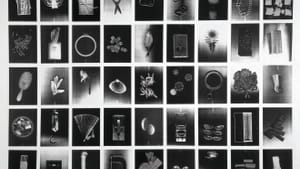Stay in the Loop
BSR publishes on a weekly schedule, with an email newsletter every Wednesday and Thursday morning. There’s no paywall, and subscribing is always free.
The copy machine never blinks
Pati Hill: Photocopier at Arcadia U.

Objects populate our lives. Many are objects of utility; they are a means to an end, placeholders for our desired outcomes. In her astonishingly prolific body of work, Pati Hill (1921-2014) utilized the transformative power of the photocopy machine to generate new ways of looking, and to capture the strange and glorious moment when one is surprised by the familiar.
Hill’s photocopies strip objects of their use value and convert them into specimens to be examined. The copy machine, Hill once remarked, “repeats my words perfectly as many times as I ask it to, but when I show it a hair curler, it hands me back a space ship, and when I show it the inside of a straw hat, it describes the eerie joys of a descent into a volcano.”
Hill came to art-making after decades as a writer, so it’s not surprising that her work ties directly to systems of language; her photocopies resemble pictograms, especially when they are arranged in a grid. The photocopy becomes the stand-in for the object itself and is perhaps the most objective form of representation: Try as the artist may to control the final image, the photocopier’s eye is its own, and peers from beneath its glass platen to produce the unpredictable. Hill’s photocopies become a universal language — a printed symbol created through the unbiased eye of a machine, unaffected by human touch.
Scissors and fruit
Pati Hill: Photocopier is located in two spaces: Arcadia University’s Art Gallery in the Spruance Art Center, and the Commons Art Gallery in the University Commons. The former contains many of Hill’s earlier forays in photocopying: several bodies of work including A Swan: An Opera in 9 Chapters, Men and Women in Sleeping Cars, Garments, and Alphabet of Common Objects (1975 – 1979), a series of 45 black and white copier prints. Alphabet of Common Objects presents myriad household things: an embroidery hoop, a pair of scissors, a mousetrap, slices of fruit. Yet I list only those to which I can assign a name. The items are interspersed among stranger images, photocopies of objects transmuted so thoroughly as to become alien to our gaze.
This arrangement calls into question the viability of such a universal language, and touches upon the poignant notion that our vision is fundamentally flawed, crippled by the limits of human biology — a truth that we so often disregard.
Voracious curiosity
The Commons Art Gallery holds many text-based projects, including Symbol Language (Hill’s attempt at crafting a universal system of hieroglyphs), Dreams Objects Moments (odes to the IBM photocopier Hill didn’t own), and Informational Art (photocopied instructions and diagrams). Also available in the Commons Art Gallery are many of the texts Hill authored, some of which contain both photocopied images and the written word. It is in these texts that I find the most direct window into Pati Hill’s poetic mind — in them, she treats the photocopy not as illustration but as muse, collaborator, and worthy subject. Her language seeks not to contain or define, but rather to remark on the impossibility of definition.
Hill was the rare artist whose work seems to endlessly expand in meaning. Her obsessive fascination with the photocopier and her obeisance to its capabilities led to a body of work that is curious, voracious in its hunger to know, yet accepting of the impossibility of total knowledge. Her work is devotional and brave. The show speaks to the wonderment of seeing something for the first time, of discovering new meaning in the banal. It is a reminder of how little we understand, and how strangely wonderful the state of naiveté can be — of how bizarre and rich and astonishing it is to exist.
What, When, Where
Pati Hill: Photocopier. A Survey of Prints and Books (1974-83). Through April 24, 2016 at Arcadia University Art Gallery, Spruance Art Center, 450 S. Easton Rd., Glenside, PA. (215) 572-2131 or gallery.arcadia.edu/pati-hill-photocopier.
Sign up for our newsletter
All of the week's new articles, all in one place. Sign up for the free weekly BSR newsletters, and don't miss a conversation.
